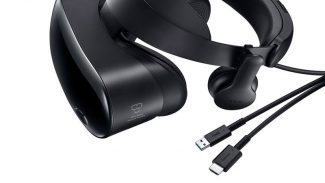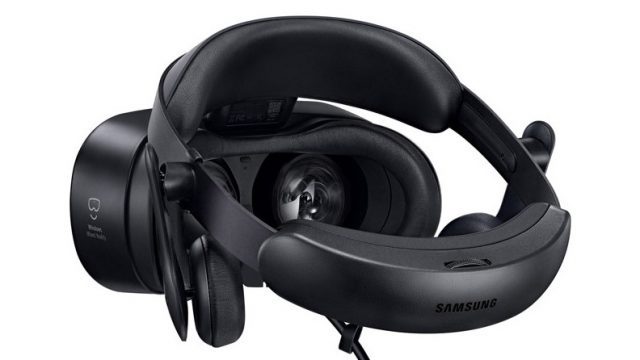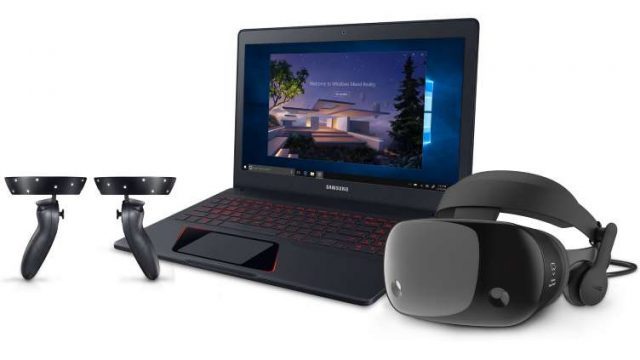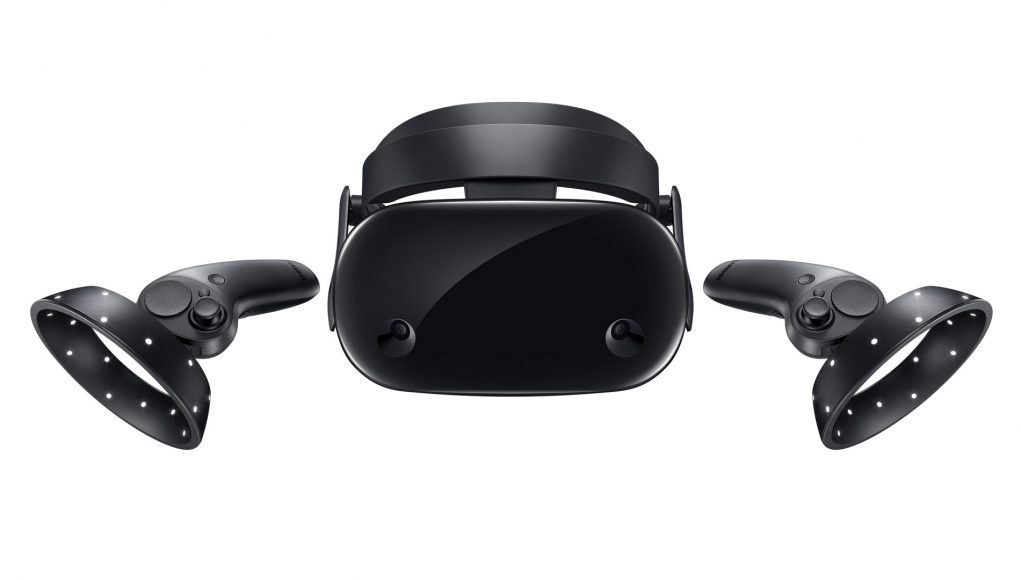The Samsung Odyssey, the company’s first PC VR headset, is available starting today in several countries, sold via Samsung and Microsoft stores. The $500 VR headset and controllers, part of the ‘Windows Mixed Reality’ platform, is described as the “most immersive,” and leads on specs (and top price) compared to the other Windows VR headsets.
Samsung Odyssey Specs and Minimum Requirements

Samsung has positioned the Odyssey VR headset as the premium offering among the Windows VR headsets, a handful of which launched initially last month.
The device lays claim to the highest resolution among the Windows VR headsets, with a pair of 1,440 × 1,600 displays (capable of up to 90Hz) which are OLED (compared to the LCD screen of the others), which typically means richer colors, greater contrast, and potentially less ghosting. The Odyssey is also the only one of the Windows VR headsets (so far) with integrated headphones and a microphone, which gives the headset a leg up in usability. Unfortunately it lacks the flip-up visor hinge that the other Windows VR headsets share.
Equipped with Fresnel lenses, Samsung claims the quoted 110 degree field of view is “one of the widest available on the market.” The Odyssey is also the only Windows VR headset to offer an IPD adjustment to let you dial in the sweet-spot by changing the distance between the lenses, from 60 to 72 mm.

Like all the Windows VR headsets to date, the Odyssey includes two front-facing cameras for inside-out tracking, which means you don’t need any external sensors or beacons for head and controller tracking. Despite Microsoft calling the Odyssey (and other Windows VR headsets) “Mixed Reality,” there is no pass-through video or augmented reality functionality from the cameras.
The headset itself weighs a hefty 1.42 pounds (644 grams), which makes it one of the heaviest consumer headsets out there. The cable is 13.1 feet (4 meters) long, and terminates in USB 3.0 and HDMI 2.0 plugs.
Need to know if you computer specs can handle the Odyssey? Download the Windows Mixed Reality PC Check app from Microsoft to make sure your system is up to par.
Our Thoughts on the Samsung Odyssey VR Headset

We haven’t had a chance to do a full review of the Samsung Odyssey headset yet, but I did get to spent a fair bit of time with the near-final headset at its unveiling last month. You can find my detailed hands-on impressions here, though here’s the short of it:
- The ergonomics didn’t quite agree with my head; I found it hard to find a spot where the headset was comfortable, in the sweet spot of the lenses, and the headphones were placed optimally on my ears.
- The lack of a hinge to flip up the visor (like the other Windows VR headsets) is a shame, and seems to also contribute to the ergonomic issue (since the visor can’t rotate from its fixed position).
- The Odyssey appears to have a wider field of view than the other Windows VR headsets, falling into the same class as the Rift and Vive.
- The hardware IPD adjustment is a nice benefit, allowing you to dial in the sweet spot of the lenses more precisely (especially useful for those with IPDs outside of the average)
- There’s a marked increase in screen sharpness over the Rift and Vive; individual pixels and the screen door effect are reduced but still visible.
- The Odyssey controllers are almost identical to the basic Windows Mixed Reality controllers, but they have a slightly more ergonomic handle shape. Otherwise they work identically well, though that does mean some jumpiness from time to time.
Additionally, our review of the Acer Windows VR headset informs some of the common elements of the underlying Windows Mixed Reality platform, like how the headset interacts with Windows, as well as the inside-out tracking tech which handles head and controller tracking.
It’s also worth noting that at present, the Windows VR headsets can only access VR content from the Windows store, which offers only a handful of apps. All of the Windows VR headsets, including the Odyssey, will eventually be able to play SteamVR content, but that functionality isn’t expected to be released until December.
Samsung Odyssey Deals and Where to Buy

Interested in picking up the Odyssey? Samsung has confirmed to Road to VR that the headset is initially available in the US, China, Korea, Brazil, and Hong Kong, via the Samsung and Microsoft stores.
At the time of writing, the Samsung.com option estimates the headset will ship in 7–10 business days, suggesting that stock there is a bit tight. The Samsung page also indicates that Rock and Rails, previously developed as a Gear VR title, will be included with the purchase.
Over at Microsoft, the current estimate is 3–7 business days, though you may also be able to find the headset in Microsoft’s brick and mortar stores (you can check inventory through the website). There’s no mention of Rock and Rails being included as a freebie when purchase from Microsoft, but the company is offering a $100 discount on a bundle including the Odyssey headset and a Samsung laptop for a hefty $2,000.







